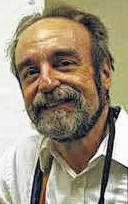
When amateur astronomers first look at galaxies in telescopes, they are invariably disappointed. “Is this what I paid $500 for?” they ask. “A smudge, a gol-danged fuzz ball?”
The view of galaxies that we get in our small telescopes would be the envy of professional astronomers just 100 years ago. A telescope with an 8-inch diameter mirror gives views of galaxies that surpass what could be seen by high-powered ‘scopes just a short time ago.
As telescopes got bigger at the beginning of the 20th century, a bit of visual detail began to emerge from the fuzz. Many of these “nebulae,” as they were called, seemed to have a distinctly spiral shape, like a child’s pinwheel.
Many astronomers assumed that the “spiral nebulae” were part of our Milky Way galaxy. Because they seemed to be made of hydrogen, and hydrogen is the main constituent of stars like the sun, perhaps the spirals were clouds of gas slowly spiraling inward to form stars. The inner core of the spiral would, according to this theory, create a star. The spiral arms would swirl around and create planets like Jupiter and Earth.
As the century progressed, a new view began to emerge. Perhaps the spirals were made of stars. Perhaps they were Milky Ways, separate galaxies at great distances from our own Milky Way. Perhaps the universe was itself composed of such “island universes.”
On the surface, the idea seemed idiotic. The Milky Way alone was thought to be tens of thousands of light years wide. One light year is equal to six trillion miles, folks. The Milky Way alone was big enough to make your brain melt if you thought too much about it. It was far more likely, some thought, that the swirling masses were “stellar systems,” stars with planets in the process of formation.
Our sun and planets constitute a stellar system. The only reason we call it the solar system is that one of the ancient names for our sun is “Sol.” We call it the solar system because nobody imagined that anything like it could possibly exist.
Percival Lowell was one of the proponents of the stellar-system theory. Lowell was at his core a dilettante, a rich amateur astronomer who wanted to make an impact on professional astronomy. His degree from Harvard was in mathematics, but he made his name traveling extensively in the Far East during the 1880s. He served for a time as a foreign minister on a Korean mission to the United States.
However, astronomy was his true avocation. In 1894, he began construction of a large refracting telescope in Flagstaff, Arizona, for his personal use. In that, he was a visionary. It was the first time an observatory-sized telescope had been built in a remote location and at high elevation, where the view of the sky is at its most spectacular.
Lowell spent the next 15 years staring at the planet Mars, and he claimed he saw canals, i.e., evidence of intelligent life, there. He was wrong about that, of course. In fact, as we shall see, Lowell was wrong about practically everything, including his support of the stellar-system hypothesis.
In an attempt to prove it, Lowell asked one of his assistants, Vesto Slipher, to study the spirals and record the spectra of the mysterious spirals. If the rainbow bands of their spectra resembled those of the planets of our own solar system, then the “solar nebula” idea would be proven.
Lowell had the instruments he needed: a large telescope and a spectroscope to attach to it.
Spectroscopes were the primary instruments of astronomy at the time. Astronomers still sometimes looked at objects visually, but the eye reveals scant information about an astronomical object. Look at a star, and you will see a point of light. Point a telescope at the same star, and you will see a point of light.
The spectroscope had changed all that. In 1814, Joseph von Fraunhofer had invented it. He soon discovered that a wealth of information was hidden in the rainbow band of a star. By studying the star’s spectrum, he could determine what chemical elements it was composed of.
Unfortunately, Lowell had a problem. His spectroscope — a complex array of mirrors, lenses, and prisms in a metal housing — weighed 450 pounds and was extraordinarily difficult to use. Lowell simply didn’t know how to use it or interpret the information it produced.
And thus it was that he hired a graduate student named Vesto Slipher for a “short-term” position at Lowell Observatory. Primarily, he was commissioned to figure out how to use the danged thing. Slipher was to remain there for 50 years.
Slipher was a farm boy from the very small and very rural town of Mulberry, Illinois. One of 11 children, he had shown excellent mathematical ability. So, off the farm he went to Indiana University to study astronomy and mechanical engineering.
Slipher’s job was to break up the light from the spiral nebulae into their component rainbow bands. First, he had to figure out how the thing worked, and he struggled mightily. At one point, he confused the slow-frequency red end of the spectrum with the high-frequency blue end. By any measure, that’s an embarrassing, newbie mistake.
As a result, Slipher didn’t begin the tedious and painstaking work of recording spectra of the spiral galaxies until 1912, 11 years after he was hired. By 1915, he had taken the spectra of only 15 galaxies.
The results were startling, to say the least. In just three years, Slipher changed the universe, or at least our human perception of it. In fact, his work during those three years led to a fundamental paradigm shift, a world-changing reinterpretation of the size, composition, and age of the cosmos — and even its creation. But for that discussion, we will have to wait until next week.


